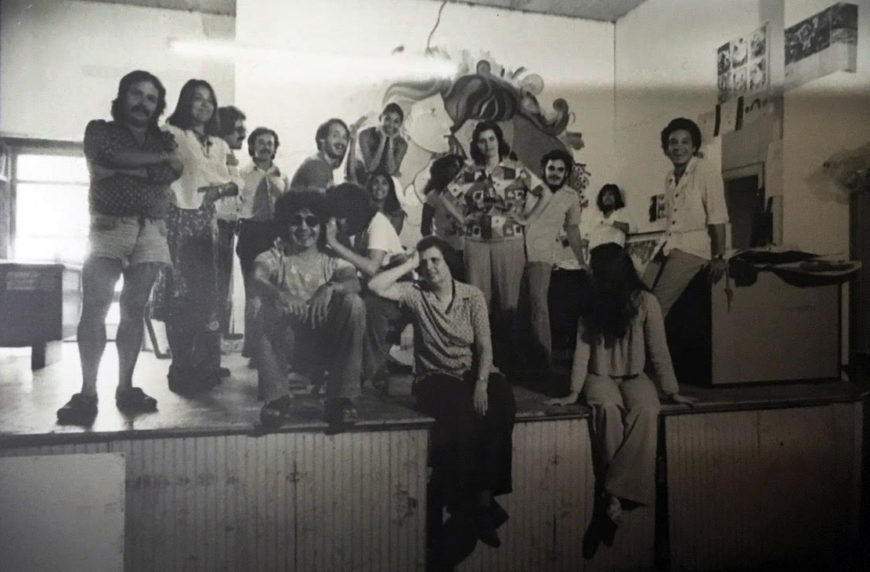
Self Help Graphics staff posing in Carlos Bueno’s work space. Partial listing from left to right: Carlos Bueno, Pete Tovar, Sister Karen Boccalero, and Sister Beth Gregory, c. 1976 (Self Help Graphics and Art Collection)
Multiple artistic centers
From the Museum of African American Art (in South LA) to Self Help Graphics and Art (in East LA), Los Angeles’s network of culturally specific art centers and museums is one of the nation’s largest. Their numbers have ebbed and flowed with the availability of public arts funding over the decades, but of those that have survived, many were formed in the fervor of the Black and Chicano Civil Rights Movements of the 1960s and 1970s. Fighting on the cultural front of these movements, these organizations created artistic projects and educational programming based in their communities’ rich cultural heritage—a heritage that was ignored in the city’s public schools and well financed art institutions. It was a variety of cultural activism that worked to serve communities and to combat the dominant culture’s perception that Black and Chicano neighborhoods were culturally deprived.
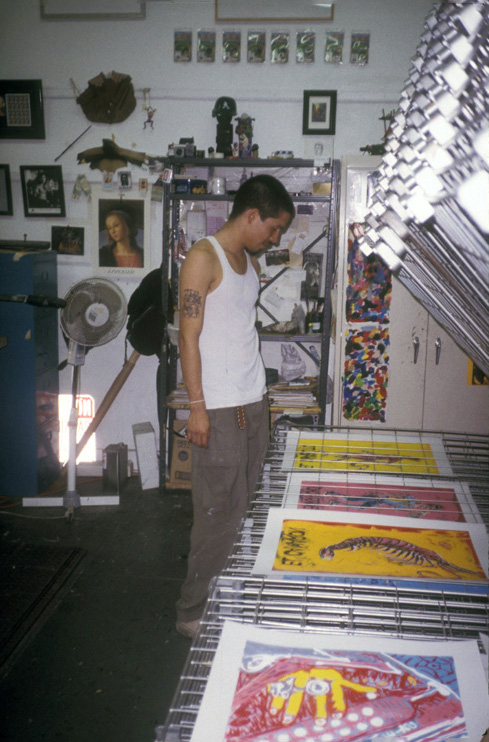
An artist examines monoprints (prints that can only be made once, unlike most printmaking which allows for multiple originals), Self-Help Graphics & Art, March 2000 (UC Santa Barbara, Special Research Collections)
On a practical level, these organizations established arts infrastructure where there was none. Setting up shop in some of the cities most disenfranchised neighborhoods, they offered all the traditional services of art schools, museums, galleries, and art advocacy organizations in one place, at no cost. When city leaders would not invest in the creative and cultural lives of neighborhoods of color, culturally specific arts centers initiated their own arts education and public programs, provided the tools and materials for making art and facilitated public artworks and spaces for community-building. Self-identified as “community art centers,” their focus was on serving the communities they were situated within through participatory public artworks like large-scale mural projects, communal print studios, and multimedia festivals and parades.
Self Help Graphics and Art

Sister Karen Boccalero, Self-Help Graphics & Art, no date (UC Santa Barbara, Special Research Collections)
Self Help Graphics and Art, a Chicana/o and Latinx community art center in Boyle Heights, offers a unique example within this history. In 1972, Italian-American Franciscan nun and artist, Sister Karen Boccalero, and queer, undocumented Mexican artists, Carlos Bueno and Antonio Ibañez, turned the garage of the Sisters of St. Francis of Penance and Christian Charity’s convent into an art studio classroom. What was once just a garage of a modern-day convent quickly became an impromptu and international community art center with artists hailing from local Chicano neighborhoods, Ecuador, and Mexico. Not just a testament to the founder’s cross-cultural appeal, it was a representation of the range of immigrants who made East Los Angeles their home.
The studio classroom garage soon became too small and, through a donation facilitated through Sister Karen’s affiliation with the Brothers and Sisters of St. Francis, Self Help moved into its first location on Brooklyn Avenue (now Cesar Chavez Avenue, named after the American labor leader and civil rights activist who advocated for migrant farm workers) in Boyle Heights. It would officially incorporate as a non-profit in 1973 offering art classes, materials, and support to aspiring artists.
Based on photographs and archival documents, we know that in its early years, the space was abuzz with activities that included screen-printing, batik (an Indonesian cloth dying technique), ink drawing, and sculpture, as well as the more routine but equally important work of exhibition preparation, filing grant applications, and even serving as a multi-function meeting space for start-up advocacy groups looking to combat discrimination against Chicana/o artists. Open to supporting any serious artistic endeavor, Self Help worked as a facilitator, as best it could, for a marginalized constituency largely absent from mainstream art institutions who nevertheless still had pressing political and creative needs.
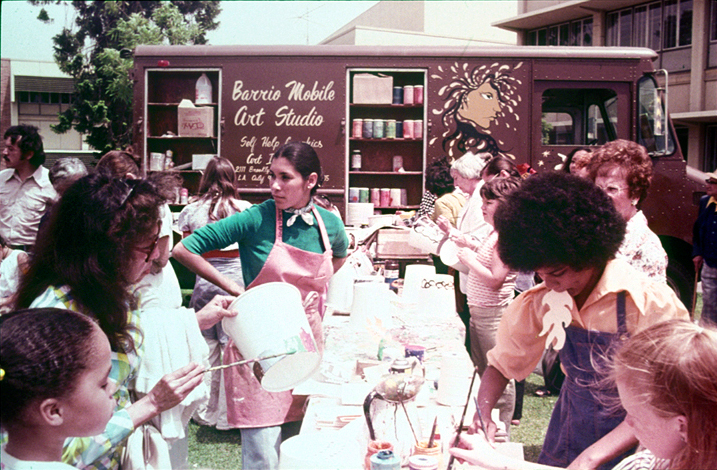
Artist teachers, students, and participants working on an art activity. The converted UPS step van in the back included a dark room for processing photographs, water and electrical hook-up, fold-out tables, and storage shelves. Carlos Bueno painted a Chicano on the side of the BMAS which served all parts of Los Angeles from Malibu to El Monte. Community Workshops and the Barrio Mobile Art Studio, Self-Help Graphics & Art, c. 1970s (UC Santa Barbara, Special Research Collections)
Sister Karen had trained under the printmaker and artist-teacher, Sister Corita Kent, in the legendary Immaculate Heart College Art Department in Hollywood in the 1960s. Self Help’s openness and willingness to support any type of creative practice or project was indebted to Kent’s own expanded and non-exclusive definition of art. For Sister Karen, art was a way of living a socially engaged and creative life in the service of others.
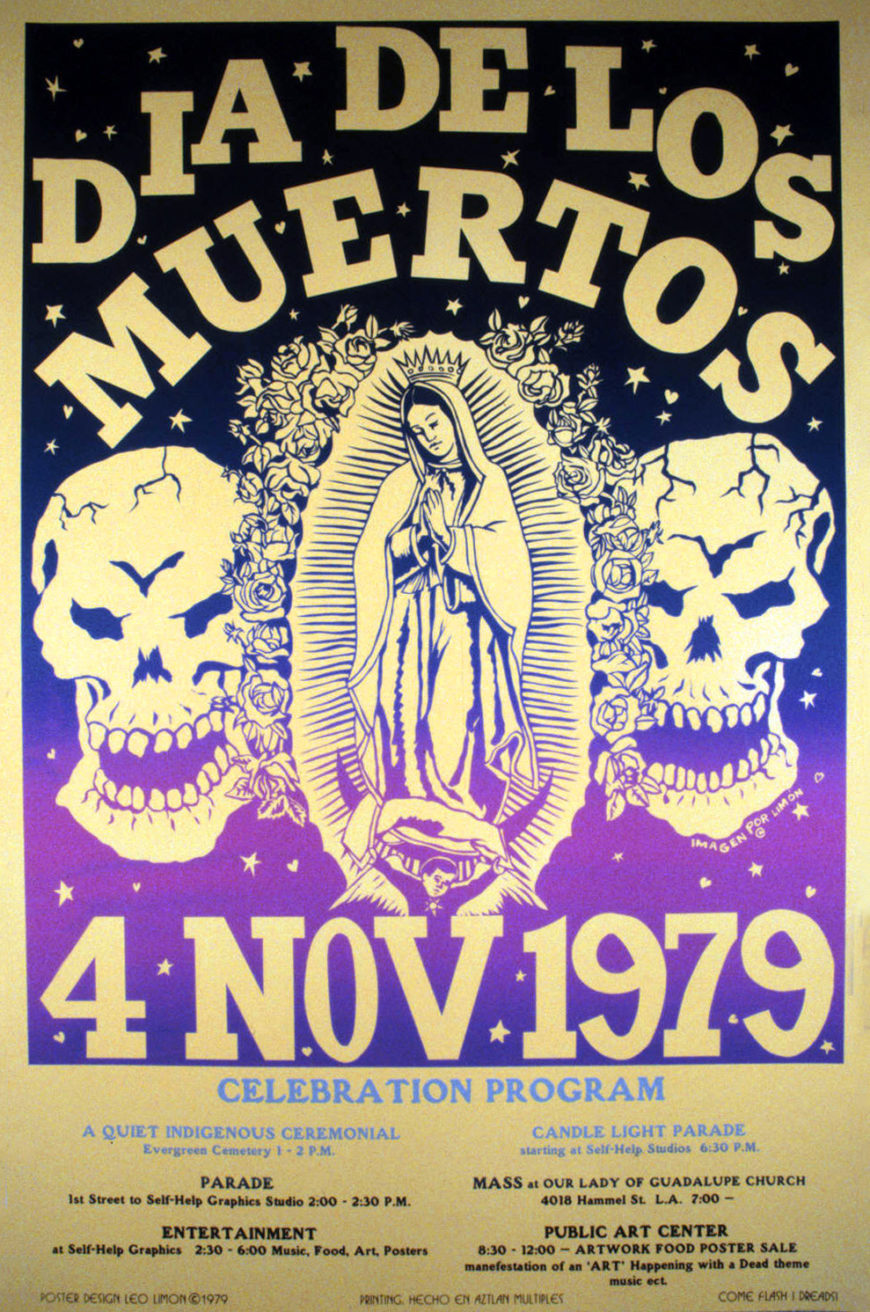
Leo Limón, announcement poster for Día de los Muertos, 1979. The image is of the Virgin of Guadalupe is paired with two skulls at each side. The poster announces events, such as: “A quiet Indigenous Ceremonial”; “Candle Light Parade”; “Parade”; “Mass at Our Lady Of Guadalupe Church”; “Entertainment”; “Public Art Center.” (UC Santa Barbara, Special Research Collections)
Self Help Graphics’ Día de los Muertos
Aware of their roles as non-Chicano artists in a predominantly Chicano neighborhood, Self Help’s founders at first struggled to find a method of connecting with their neighbors beyond the coterie of affiliated artists who worked in the space. Sister Karen had been trained as a master printer at the Tyler School of Art at Temple University in Philadelphia, and her co-founders Carlos Bueno and Antonio Ibañez trained as muralists and draughtsmen at the Academy of San Carlos in Mexico City. Despite coming from distinct artistic traditions and training, they found overlap in their commitment to a socially engaged artistic practice in the service of others. It was in this overlap that they worked together to facilitate participatory art frameworks that both served and manifested Chicano community.
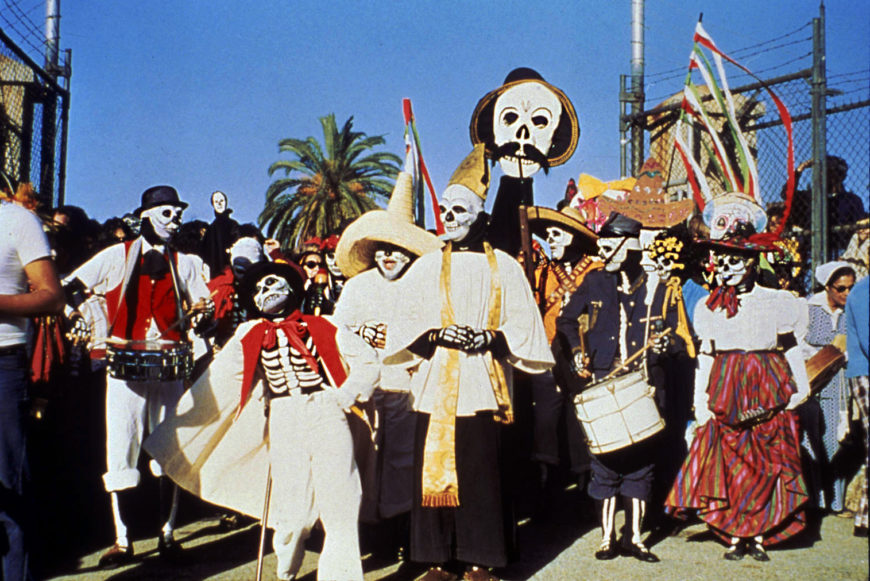
Day of the Dead ’77 Procession, Self-Help Graphics, November 1977 (UC Santa Barbara, Special Research Collections)
The collaborative Día de los Muertos procession and festivity would become the most well-known. Beginning in 1973, the trio of founders and affiliated artists partnered to redeploy the Mexican Día de Muertos for their neighborhoods in East Los Angeles. A Catholic and Indigenous Mexican celebration of the dead, Día de Muertos is traditionally celebrated on November 2, although preparations begin the week before when celebrants prepare and gather decorations, mementos, specific foods, and flowers, and construct altars of remembrance at the cemetery or in their homes.
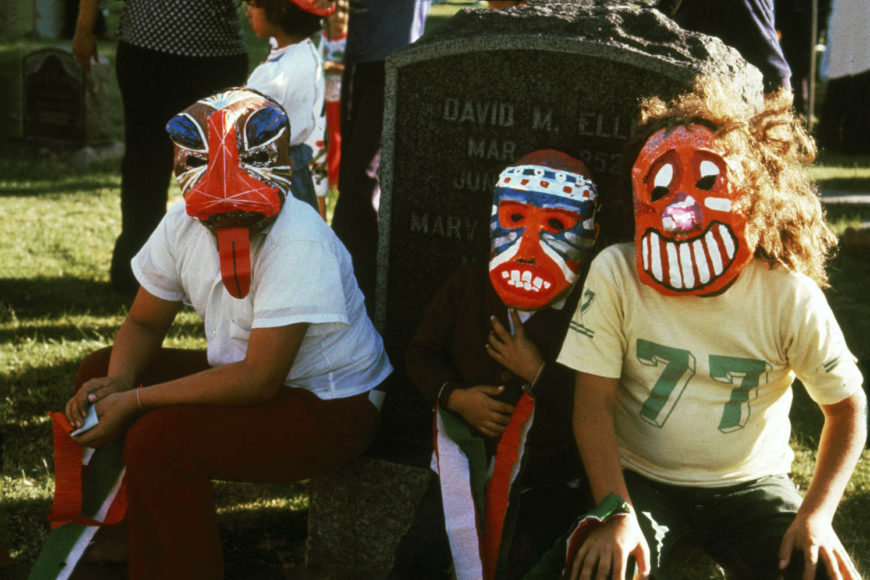
Day of the Dead ’77, Self-Help Graphics, November 1977, (Self-Help Graphics and Art archives, UC Santa Barbara, Library, Department of Special Research Collections)
Marigolds are often scattered from the grave to their respective altar to ensure ancestors find their favorite objects, foods, and acknowledgements, thereby completing the ritual that will bring good fortune to family members. Altar-making is common to Chicano and Mexican households, but there was no equivalent holiday-like ritual in Los Angeles.
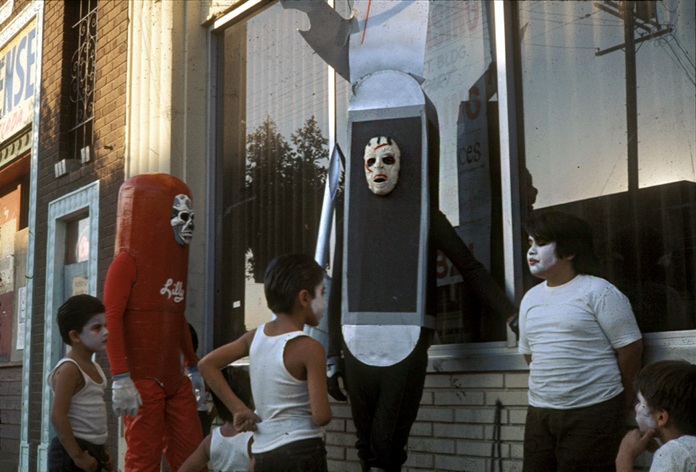
Artists and child participants resting in Asco’s Three Causes of Death (1976). Asco artists are costumed as a switchblade and a pharmaceutical drug along with children dressed as zombie cholos all referencing the linked realities of addiction, murder, and violence caused by these items in East Los Angeles. ASCO, Self-Help Graphics & Art, November 1976 (UC Santa Barbara, Special Research Collections)
The first Día de los Muertos in Los Angeles began as a collaboration with Self Help and Chicano art collectives like Asco (Spanish for “disgust”) and Los Four. The procession of mostly elementary and college students began with a Catholic mass in Evergreen Cemetery and ended at Self Help Graphics’ location on Brooklyn Avenue where participants laid marigolds (traditionally used by the Indigenous peoples of Mexico) to guide spirits to the traditional multi-stepped altar created to commemorate the dead.
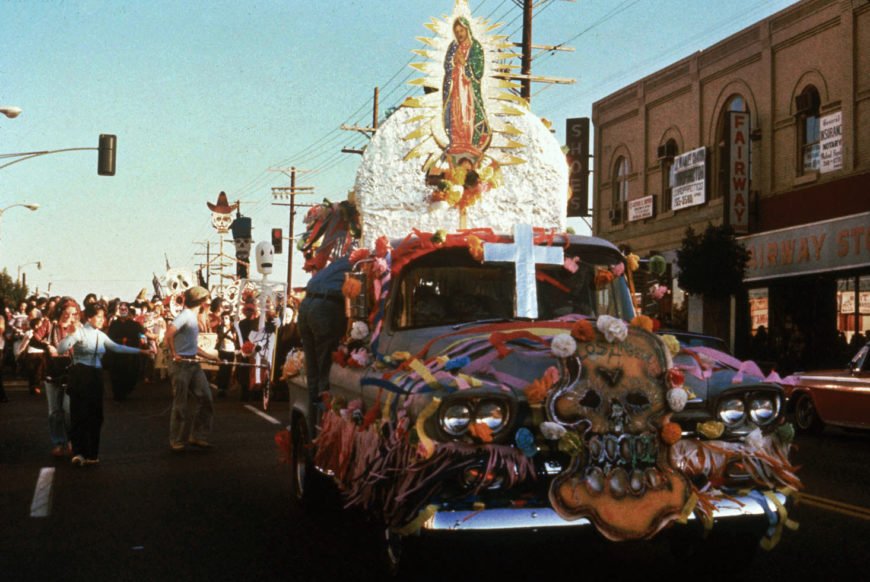
A float designed for Día de Los Muertos by Leo Limon processes down Brooklyn Avenue bedecked with an image of the Virgen de Guadalupe, a silver cross and a grinning calavera (skull) on the front. Day of the Dead ’77, Self-Help Graphics, November 1977 (Self-Help Graphics and Art archives, UC Santa Barbara, Library, Department of Special Research Collections)
Subsequent iterations expanded on this structure, eventually including elaborate floats, handmade costumes, painted faces, theater performances, live music, and exhibitions of artworks made by local school children.
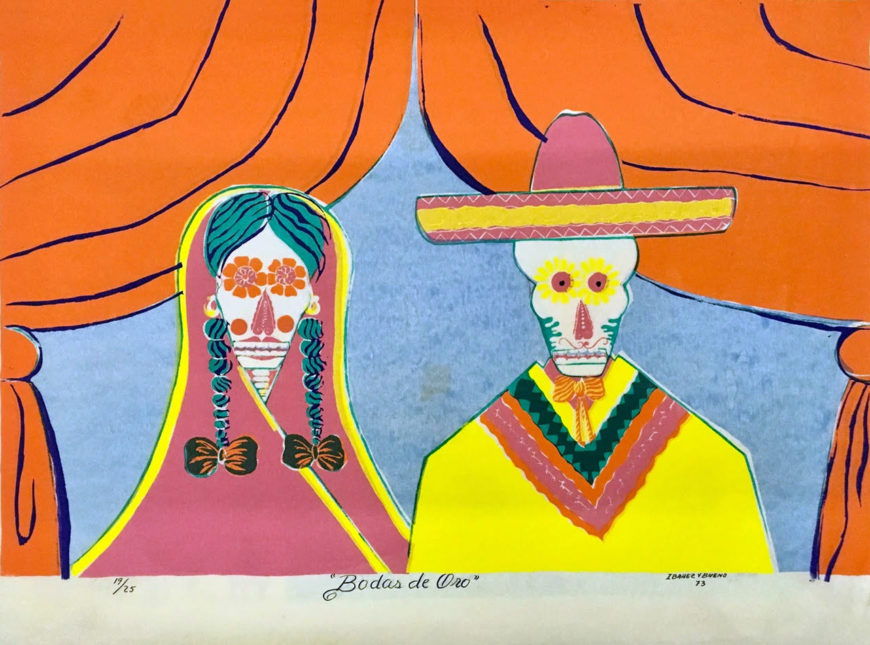
Carlos Bueno and Antonio Ibañez (Ibañez y Bueno), Bodas de Oro, 1973, silkscreen, Self Help Graphics and Art Collection
Ibañez y Bueno produced Bodas de Oro (Wedding Anniversary) most likely as a commemorative print for Self Help’s first Día de los Muertos in 1973. The artists relied on their Mexican compatriot, the great José Guadalupe Posada, who had developed the calavera (skeleton) as his signature visual vehicle through which he interpreted late 19th- and early 20th-century Mexican society, politics, and cultural practices. Great admirers of the master printmaker, Ibañez y Bueno depicted a village wedding anniversary in which two calaveras wearing traditional dress sit below a curtain. While Ibañez y Bueno lived in East Los Angeles, this print is a reminder that they dwelled in a Mexican cultural imaginary which made them an important reservoir of practices, visual vocabularies and attire from a wide range of Mexican places. The artists drew from this wealth of experiences in re-deploying the Mexican tradition in Los Angeles.
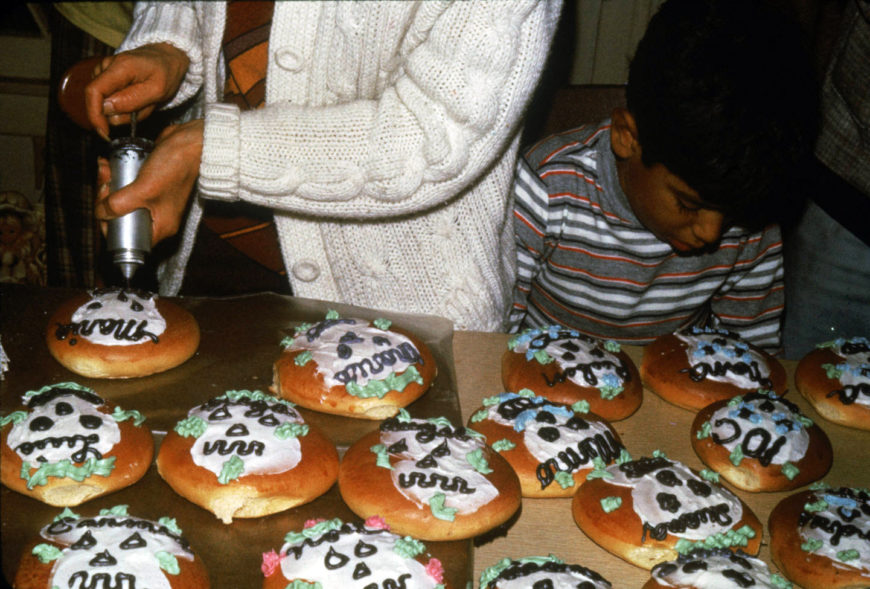
Day of the Dead ’77 Bread-Making (Pan de Muerto) Workshop, Karen Boccalero, November 1977 (Self-Help Graphics and Art archives, UC Santa Barbara, Library, Department of Special Research Collections)
Día de Los Muertos intentionally blurred the boundaries between life, death, art, audience and observer, asking a community to join in festivities in which everyone had a role to play. Invested in an art-making that facilitated dialogue and manifested community, the collective performance would become a hallmark event in East Los Angeles and eventually become synonymous with Los Angeles itself.
Current headquarters of Self Help Graphics & Art at 1300 E. 1st Street in Boyle Heights
An ongoing ally
Approaching its 50th year anniversary, Self Help has continued to serve and adapt to the needs of an increasingly pluralistic Latinx Los Angeles. Very much as it began, the organization still helps artists with grant applications and remains an important facilitator between the ambitions of young artists and the realities of implementation. Directly in line with the legacy of its founders, it continues a tradition of socially engaged cultural work that addresses not only Chicanx issues, but those that affect the broader Latinx community, ranging from the need to encourage Latinxs to participate in the 2020 census to the need to train and nurture a new generation of Latinx cultural workers and researchers. Now one of the oldest community art centers in the city, Self Help remains a stalwart ally to the evolving needs of the great creative cauldron of East Los Angeles.
Additional resources
Check out Self Help Graphics & Art’s instagram
Self Help Graphics and Art archives
Learn more about the exhibition Arte Sin Fronteras: Prints from the Self Help Graphics Studio at the Blanton Museum of Art
Watch a PBS episode about Día de Los Muertos / Day of the Dead
Read about the Royal Chicano Air Force

